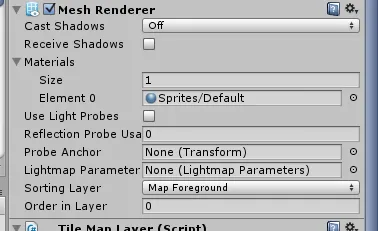我正在制作一个由2D和3D元素组合而成的等轴测游戏。我想知道如何使我的玩家和敌人精灵(全部由2D元素组成)不会在我的3D元素后面或里面渲染。
所以我已经尝试过通过更改renderQueue并将这些岩石等材质的渲染队列设置为高值,使它们绘制在2D元素后面。
然而,在我的搜索中,我发现实际上需要设置对象的ztest来纠正这个问题。这让我有点困惑,因为我没有真正使用过着色器。我找不到任何合适的参考资料,解释如何准确地解决这个问题,只有一些假定先前知识的写作,比如this。我尝试下载Unity着色器并打开默认的精灵着色器,但我不确定在哪里更改ztest或标记来解决这个问题。
以下是Unity的标准精灵着色器:
更新 1
然而,在我的搜索中,我发现实际上需要设置对象的ztest来纠正这个问题。这让我有点困惑,因为我没有真正使用过着色器。我找不到任何合适的参考资料,解释如何准确地解决这个问题,只有一些假定先前知识的写作,比如this。我尝试下载Unity着色器并打开默认的精灵着色器,但我不确定在哪里更改ztest或标记来解决这个问题。
以下是Unity的标准精灵着色器:
// Unity built-in shader source. Copyright (c) 2016 Unity Technologies. MIT license (see license.txt)
#ifndef UNITY_SPRITES_INCLUDED
#define UNITY_SPRITES_INCLUDED
#include "UnityCG.cginc"
#ifdef UNITY_INSTANCING_ENABLED
UNITY_INSTANCING_BUFFER_START(PerDrawSprite)
// SpriteRenderer.Color while Non-Batched/Instanced.
UNITY_DEFINE_INSTANCED_PROP(fixed4, unity_SpriteRendererColorArray)
// this could be smaller but that's how bit each entry is regardless of type
UNITY_DEFINE_INSTANCED_PROP(fixed2, unity_SpriteFlipArray)
UNITY_INSTANCING_BUFFER_END(PerDrawSprite)
#define _RendererColor UNITY_ACCESS_INSTANCED_PROP(PerDrawSprite, unity_SpriteRendererColorArray)
#define _Flip UNITY_ACCESS_INSTANCED_PROP(PerDrawSprite, unity_SpriteFlipArray)
#endif // instancing
CBUFFER_START(UnityPerDrawSprite)
#ifndef UNITY_INSTANCING_ENABLED
fixed4 _RendererColor;
fixed2 _Flip;
#endif
float _EnableExternalAlpha;
CBUFFER_END
// Material Color.
fixed4 _Color;
struct appdata_t
{
float4 vertex : POSITION;
float4 color : COLOR;
float2 texcoord : TEXCOORD0;
UNITY_VERTEX_INPUT_INSTANCE_ID
};
struct v2f
{
float4 vertex : SV_POSITION;
fixed4 color : COLOR;
float2 texcoord : TEXCOORD0;
UNITY_VERTEX_OUTPUT_STEREO
};
inline float4 UnityFlipSprite(in float3 pos, in fixed2 flip)
{
return float4(pos.xy * flip, pos.z, 1.0);
}
v2f SpriteVert(appdata_t IN)
{
v2f OUT;
UNITY_SETUP_INSTANCE_ID (IN);
UNITY_INITIALIZE_VERTEX_OUTPUT_STEREO(OUT);
OUT.vertex = UnityFlipSprite(IN.vertex, _Flip);
OUT.vertex = UnityObjectToClipPos(OUT.vertex);
OUT.texcoord = IN.texcoord;
OUT.color = IN.color * _Color * _RendererColor;
#ifdef PIXELSNAP_ON
OUT.vertex = UnityPixelSnap (OUT.vertex);
#endif
return OUT;
}
sampler2D _MainTex;
sampler2D _AlphaTex;
fixed4 SampleSpriteTexture (float2 uv)
{
fixed4 color = tex2D (_MainTex, uv);
#if ETC1_EXTERNAL_ALPHA
fixed4 alpha = tex2D (_AlphaTex, uv);
color.a = lerp (color.a, alpha.r, _EnableExternalAlpha);
#endif
return color;
}
fixed4 SpriteFrag(v2f IN) : SV_Target
{
fixed4 c = SampleSpriteTexture (IN.texcoord) * IN.color;
c.rgb *= c.a;
return c;
}
#endif // UNITY_SPRITES_INCLUDED
更新 1


